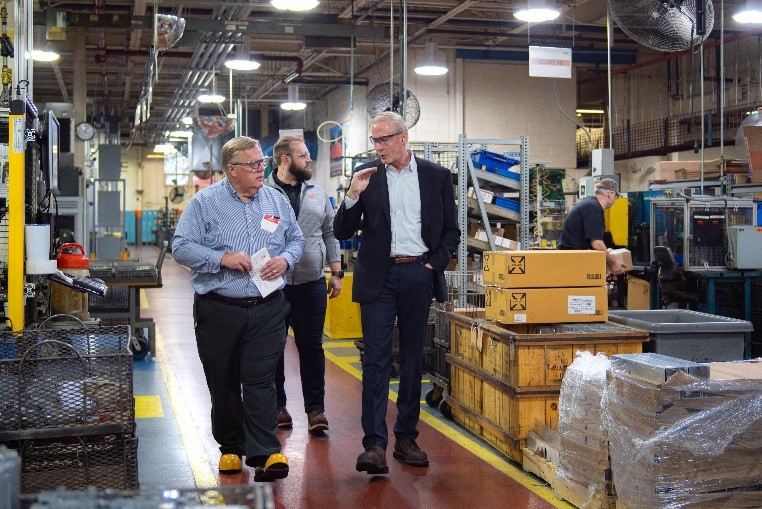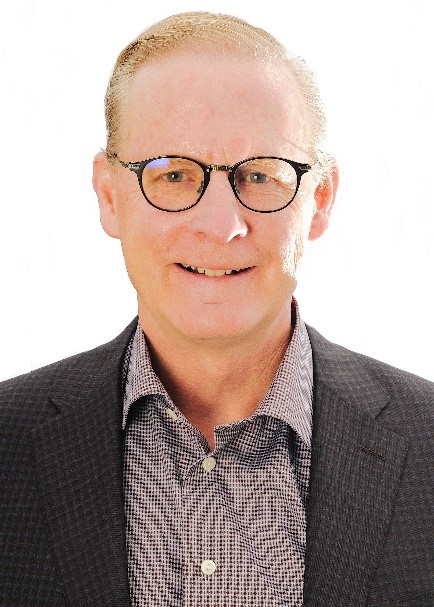
Dave Petratis served as Allegion CEO from 2013 to 2022.
A childhood in Council Bluffs
Dave Petratis was born in 1957 in the town of Council Bluffs, Iowa, which is just across the Nebraska-Iowa border. When Dave was only five years old, his father passed away, leaving his mother, an industrial nurse for Western Electric, on her own to raise and provide for six children.
Dave began working at six years old, serving as cheap labor on his uncle’s farm every summer. He recalls his uncle picking him up from school on the last day of the year, taking him for a “buzz cut” and then heading to the farm where he would work the rest of the summer break until he was about 13 years old.
Dave graduated from Abraham Lincoln High School in 1976 and continued his education at Iowa Western Community College on a basketball scholarship. He also took a job working at an electrical supply house, where he was first exposed to electrical components – something that would help him land his first job after college graduation.
At Iowa Western, Dave studied industrial management. Dave thought he would pursue a career in purchasing post-graduation and the thought of working in manufacturing never crossed his mind. However, the economy had different ideas. With unemployment rates at an all-time high, jobs were scarce and college graduates were lucky to find work. Dave was one of only three individuals from his 1978 graduating class to leave school with a job offer.
Dave’s start in manufacturing
Dave accepted a job as a first line supervisor with an electric company in Nebraska, which he received not for his academic performance but for his previous work experience at the electrical supply house. Although he had always been an extremely hard worker in the gym and professionally, he did just enough to get by in school and assumed everyone else in the room was smarter than himself.
Although he didn’t feel much like a leader, his first day on the job, Dave was responsible for 72 direct reports and navigating a hostile work environment. While he would have been happy working second shift, Dave was offered a first shift position, and that didn’t sit well with others who had to earn that shift over time. While he didn’t enjoy the job, he learned quickly what it meant to manage people.
Dave found learning to be an invaluable skill – from learning about his work to learning about himself. He especially found value in problem-solving techniques, process mapping and how to provide feedback. When management made a huge financial investment in a new piece of automated equipment that began to malfunction, Dave applied his learnings from books by problem-solving leaders Edward Demings and Joseph Juran. After working on the equipment for 18 months, Dave and his team had redesigned the machine to actually exceed the specified output limits.
After serving as a first line supervisor, Dave spent time in a variety of manufacturing areas at the company, including assembly, fabrication and molding. While he accepted some of these roles for the pay raise, behind the scenes he was also learning the ins and outs of each of these manufacturing processes.
Career advancements
At just 24 years old, Dave was promoted to night shift manager and was responsible for 300 direct reports and all aspects of the highly sophisticated operation. Dave continued to advance in the company, later accepting roles at their North Carolina plant and then South Carolina plant. While the Nebraska and North Carolina plants were primarily high volume, build-to-stock operations, South Carolina presented the new challenge of managing a customized, build-to-order operation.
He accepted the position of plant manager in South Carolina in November of 1989, knowing that the previous seven occupants of this role had all been fired. While the company struggled to decide whether to keep the doors open on the facility, Dave didn’t let this distract him. Instead, he focused on understanding why the previous managers had failed. What he discovered was they were trying to apply the same performance metrics from the Nebraska plant to South Carolina, even though they were a completely different operating model. He also learned employees did not have the correct tooling to do their jobs, and they were never given a clear vision for the future of the company. Although he didn’t know it at the time, these were lessons he would take with him throughout his career.
After experiencing this “aha!” moment, Dave knew he had to do something to inspire his employees. He told them that while they couldn’t control whether the company decided to close the doors or not, there were other things that were in their control. He tasked them with working safely, improving quality, increasing customer satisfaction and improving processes.
Dave promised that if his employees helped him tackle these areas for improvement, he would fight to get financial backing to purchase the equipment they needed. He also gave them a clear picture for how they could work together and a vision they could believe in. As a result, the South Carolina plant became a model facility, and went on to become one of the first to be International Organization for Standard (ISO) registered. It was also named the 1990 Manufacturer of the Year and one of the 10 Best Plants on the Continent in 1993.
As the plant grew and they began to invest in new tooling, Dave realized that just buying the tools wasn’t enough. With new advancements in technology, he also needed to invest in training and development for employees. He wanted to ensure they had opportunities to learn – especially as he credits much of his own career success to his willingness to learn both on and off the job. He recalls, “Whenever there was an opportunity to learn, my name was on the list.”
Throughout Dave’s time at the company, they invested a lot of time and money into his development. He was a member of the National Management Association, an organization of managers that provided onsite learning and certification programs. After each of his shifts, he would stay at the plant developing his coaching and managerial skills. He even spent a week with Geary Rummler, a well-renowned author and strategist, learning about process mapping – a skill he still finds invaluable today.

A wrench in the plans
While working at the South Carolina plant, Dave began his MBA at the University of South Carolina with the company’s support. He was nearly halfway through the program when he was thrown an unexpected curve ball. He was asked to move himself and his family across the country to California to help the company turn around a failing critical power business. Dave remembers this request was really more of a demand. He was forced to decide within 24 hours without ever seeing the business. If he agreed, he was promised the title of president; and if he declined, he was assured his career at the company as he knew it would be over.
Dave accepted the challenge site unseen and moved his family to California. On day one of the new job, an entire level of management was fired, and it turned out the business was in much worse shape than he could have imagined. Dave vowed then and there that he would never force someone into a decision like he experienced. “People have choices. Let’s make sure they know that and have all of the information.”
Dave was able to help stabilize the business in California and was, in fact, named president. However, much to Dave’s surprise, the company decided to put it up for sale and Dave was told his position would be going along with it. For the next phase of his career, Dave continued to work for the company who had acquired him. While the sale was a bitter pill for Dave to swallow at the time, 10 years later, he had the opportunity to work for the company where he started his career once again – this time as CEO.
As CEO, Dave helped take the company from a $2 billion business to a $5 billion business. His focus was on pricing levers and building a system of quality and customer satisfaction that was certified by ISO. In his 10 years away from the company, Dave had the opportunity to be one of their customers, and he realized that there was a lot of room for improvement when it came to customer service. He learned that it is essential to stretch around and see the business from the eyes of the customer. “We must have our ears, eyes and hearts open to understand, from the perspective of the customer, what the opportunities are.” He realized the harder they pushed on quality and customer satisfaction, the more the business grew.
Applying his learnings to Allegion
Dave was named the CEO of Allegion during the Ingersoll Rand spin-off in 2013. Dave says, “The job at Allegion was a new challenge for me. It really has exceeded my wildest dreams.” He recognizes that he wouldn’t be where he is today if it wasn’t for all of the learning and cumulative experiences along the way.
In fact, many of the experiences and lessons Dave accumulated in his early years can be seen in application at Allegion today. He learned how important it was to share a clear picture of the future with employees during his time at the South Carolina plant. Today, Dave makes it a priority to share the strategic vision with each member of the organization and references the vision and values frequently.
“Be safe, be healthy,” is one of Allegion’s core values that Dave drives home daily. In his career, he has experienced the devastating loss of an employee as the result of a mistake that compromised safety. He reflects that although he thought their safety standards were great, they could have been better that day. Dave believes, “Safety is the true north metric of manufacturing excellence.”
He also learned that one of the keys to a successful business is to provide employees with the tools and resources to get the job done right. He vowed that if Allegion was going to be in business, people would have the tooling to do the job correctly or they wouldn’t be able to compete. He also learned the importance of providing excellent service to customers throughout his many roles. In each of them, he saw that the more they focused on serving the customer, the better the growth of the company.
Dave uses each of these learnings from his past and more to help shape how he leads Allegion today. According to Dave, the process of learning is never complete, and he will continue learning every day.



